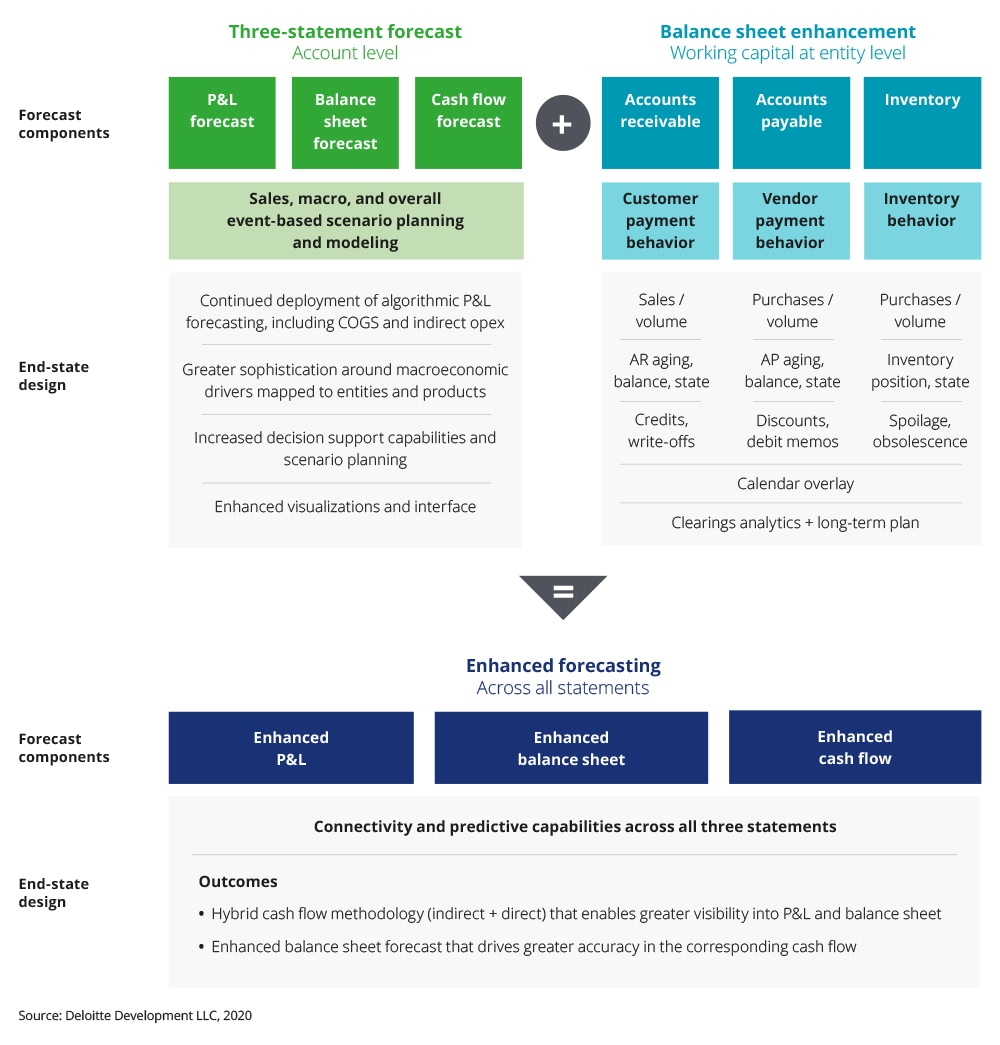Enhanced cash flow forecasting and working capital has been saved

Perspectives
Enhanced cash flow forecasting and working capital
A more efficient and agile approach to cash flow forecasting
The unprecedented global business disruption caused by COVID-19 has highlighted the need for enhanced capability and agility in the management of working capital, cash flow forecasting, and overall liquidity.
Explore content
- A renewed focus on cash flow forecasting
- Building the forecasting capability
- From hindsight to foresight
- Lessons learned
- Get in touch
A renewed focus on cash flow forecasting
In response to the COVID-19 crisis, many CFOs have shifted focus from long-term P&L and growth planning to more immediate business continuity risks and cash positions.
This shift has—for better or worse—thrown organizations’ current forecasting and scenario modeling capabilities into the spotlight and, with cash top of mind, has exposed many organizations’ lack of attention to cash flow forecasting. Additionally, many companies perform their forecasts at such an aggregated level that it may affect the ability to understand the liquidity impact of nuanced behaviors that customers and vendors exhibit during these events. Lack of visibility into details can hamper the flexibility to create different scenarios, which is critical to navigating a path forward.
As organizations begin to emerge from the initial “respond” phase of the crisis and consider long-term implications or scenarios, they would be remiss to not build on the lessons learned thus far in managing their business during disruption—such as renewed focus on cash flow forecasting—by continuing to build and enhance their capability and speed, in an effort to make proactive and informed decisions that affect liquidity.
Deloitte has developed an approach to cash flow forecasting that combines our advanced analytics capabilities with hybrid forecasting methodologies to establish the foundation for more precise forecasts that integrate and reconcile across financial statements. Our approach enables efficient, in-depth analysis without the manual effort typically required when performing scenario analysis.
Building the forecasting capability
Foundation: A three-statement model
The financial crisis highlighted the importance of integrated forecasting and cross-functional planning. While truly anticipating black swan events may not be possible, being prepared to react promptly and decisively can be facilitated by forecast practices that encompass relevant business drivers across three financial statements: P&L, balance sheet, and cash flow. Our hybrid approach is built on an integrated model combined with a deeper transaction-level analysis of working capital accounts. The real-time linkage between the three statements, along with the capability and confidence to forecast each one, enables a higher-quality view of and can help companies better prepare for unparalleled events.
For example, during the COVID-19 crisis, many companies shifted their focus to very practical measures, like days of cash on hand, as opposed to traditional performance metrics like revenue and EBITDA. This left some scrambling, as they couldn’t model the impact of changes in working capital with their traditional forecasting methods. A hybrid three-statement model allows companies to efficiently gain visibility and predictability to future cash positions through connected financial statements.
Understanding customer, item, and vendor behaviors
The hybrid approach combines multiple forecasting methodologies, along with advanced analytic capabilities, to offer greater detail, visibility, and consistency with a net decrease in the effort. A component of this approach is forecasting at the customer, item, and vendor level using the direct method. Forecasting at this level of detail provides keen insight into future cash flows and allows for customer and vendor behavior scenarios to be incorporated into the forecast. An illustration of this is forecasting accounts receivable at the customer level and accounts payable and inventory at the vendor level. These accounts are highly liquid and are effective predictors of upcoming cash disbursements and receipts when combined with the income statement forecast.
Metrics that monitor changes in consumer or vendor behavior should be evaluated and factored in alongside an advanced capability to ingest and make sense of external indicators that may arise. Examples include localized consumer mobility or retail outlet closings and openings during disruption. The ability to dynamically adjust models on the fly is a hallmark of more advanced predictive forecasting platforms.
Hybrid forecasting framework
Click image to enlarge
The “right” methodologies depend on your unique circumstances
In practice, many companies forecast using just one methodology, often the indirect method. While cash flow information is readily accessible through the accounting and finance functions, it does not provide enough detail to correctly predict future cash and liquidity positions. As uncertain business climates persist, better insight into liquidity is crucial to enabling sharper business decisions. A hybrid forecasting approach can provide greater insight by combining multiple methodologies, helping to increase accuracy and visibility for better business decisions.
With a platform that provides the flexibility to dynamically add, subtract, or change the combination of modeling approaches, you can enhance value by adapting effectively to changing scenarios and circumstances. A platform that can test multiple forecast methodologies can inform the user which methodology or combination of methodologies is relevant to each specific time horizon.
When forecasting the balance sheet and cash flows, there are typically six specific methodologies to consider: Historical clearings overlay, clearings analytics, the direct method, working capital components, the indirect method, and long-term planning. Each approach aims to solve a different set of use cases dependent on time horizon, accuracy requirements, and data availability.
While our cash flow forecasting approach can be adapted to meet the specific circumstances of each business, the combination of methodologies each organization should select is variable and will depend on the type of company and its current situation (business archetype). Advanced data science and machine learning techniques help organizations dynamically pivot to an effective combination of approaches and methodologies.
(More on the various methodologies and business archetypes can be found in the PDF available above).
Advanced scenario forecasting and workforce capacity
Without a historical business context to provide guidance during the COVID-19 pandemic, the challenge of predicting the future market and consumer behavior is exacerbated. Predictive analytics, algorithmic forecasting, and driver-based forecasting strengthen the foundation built from a hybrid approach. As a capability, algorithmic forecasting can improve forecasting and advanced scenario modeling and can free up capacity for your finance workforce to focus on more value-added activities.
Algorithmic modeling and forecasting use statistical models to describe what’s likely to happen in the future. It’s a process that relies on warehouses of historical company and market data; statistical algorithms chosen by experienced data scientists; and modern computing capabilities that can make collecting, storing, and analyzing data fast and affordable. Forecasting models offer increased value when they can account for biases, handle events and anomalies in the data, and course-correct on their own. That’s where machine learning comes into play. Over time, working capital optimization improves as algorithms “learn” from previous cycles.
From hindsight to foresight
PrecisionViewTM enables you to crawl, walk, run
Deloitte’s PrecisionView solution combines data science, machine learning, and advanced visualization to help companies along their advanced analytics journey. Whether your organization is new to analytics or has a solid foundation in place, PrecisionView can help unlock advanced insight generation, predictive models, and cognitive capabilities. Most importantly, PrecisionView integrates these methods and capabilities into your ways of working, making a broad impact on the organization by putting the power of the solution in the hands of your business partners.
For many companies and situations, the most effective way to forecast cash and the balance sheet is a hybrid approach combined with advanced analytics capabilities.
With our hybrid forecasting and advanced analytics solution, companies can forecast cash at a monthly level of detail for four to six quarters. Using statistical algorithms, PrecisionView identifies the best methodologies and economic organizational drivers meaningful to your organization for cash flow forecasting. These drivers are then applied to the model for a more precise picture of all three reconciled financial statements.
Hybrid + PrecisionView
Click image to enlarge
PrecisionView leverages data aggregation technologies to provide a streamlined experience for businesses to generate high-impact insights. Its ability to produce accelerated financial insights allows for agile scenario planning, empowering organizations to shift their focus from analysis to decision-making.
(More on PrecisionView operating models and an illustrative roadmap can be found in the PDF available above).
Lessons learned: Predictive forecasting
From our experience in predictive forecasting, we have learned from, and developed mitigations for, implementations:
Lessons learned
Click image to enlarge
Getting started
Many organizations start by selecting a part of their business or a specific revenue, product, or cost element to use as a pilot or proof of concept before implementing a wholesale change to their forecasting process.
If you are interested in getting started or want to learn more, please contact one of us below and visit our PrecisionView site for more information.
Recommendations
How to execute annual financial planning and forecasting in today’s environment
Strategies for companies, CFOs, and planning leaders
Reinventing FP&A for the pandemic and beyond
CFO Insights








